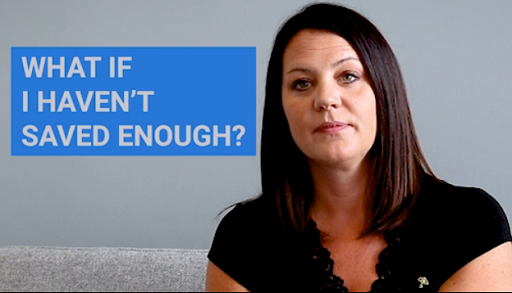7 Dealing with a shortfall
You should now have a much better picture of what your income will look like when you retire. Of course, these projections of your income and spending are not certain as the cost of living, your personal circumstances and your income can change. But if you’ve followed the previous steps, you should have a good idea if your pension income will be enough to fund the retirement lifestyle you want.
If you think you might have a shortfall, you’ll need an action plan. In the next video, Emma Byron from Legal & General reviews the options that may be available.

Transcript: Video 7
[MUSIC PLAYING]
If you're really concerned about not having enough to support you through retirement, there's a number of different things that you could do. Firstly, you could choose to delay your retirement. And the benefits of that would be twofold. So firstly, you'd still be contributing to your pension, hopefully. And secondly, you'll be taking that over a shorter period of time. So that can be a real option for people who don't feel they've saved enough.
The other things you could do is you could continue to work part time. So often people will transition into retirement more gradually rather than an abrupt stop from full time work to part time work. You might want to not keep up the daily commute or whatever it is you've been used to and working at that pace. But perhaps you've got an interesting hobby or a skill like dog walking, carpentry that you could make an extra income from. So there's always something to think about in a more creative way that might be a bit more fun than your current day job.
But don't worry if you do need to retire now and you're worried about having an income shortfall, the course is going to cover different options that might help you.
[MUSIC PLAYING]
As Emma indicates, you may have several options to ‘balance your books’.
- First, look again at your planned spending. Is there non-essential expenditure that you can cut back on when you retire? This may be all you need to do to cover a modest shortfall.
- If the shortfall is larger, you may need to take difficult decisions to balance your budget. So when looking at your non-essential spending do assess which of these items you could, albeit reluctantly, cut back on – or even cut out entirely - with the least impact on your quality of life.
- You should see if you can clear any outstanding debts – perhaps using the tax-free lump sum(s) from your pension(s). This will not only reduce your future monthly outgoings, but also give you peace of mind that you don’t owe anything.
- You could continue to work past retirement age, perhaps part-time or in a temporary role. This could help ease the move from full-time employment to retirement and soften the impact that comes from no longer being part of a working team. Remember that your earnings will be taxable.
- Retiring later means you can usually get a higher pension income when you do retire, especially if you keep up your pension contributions and any savings built up will have a shorter time to last.
- Perhaps you have other savings that you could use? Drawing a pension lump sum or cashing in other investments when you retire can provide you with extra money to subsidise your retirement income. Keep back a ‘rainy day’ fund to cover for unplanned expenses – like repairs to your home. Ideally this fund should amount to at least two years of household expenditure and would provide cover not only for unexpected bills but also for a fall in value of the investments in your undrawn pension pot.
- You might be expecting to receive an inheritance, providing another lump sum to draw on. The inheritance may include a property that you could sell or use to provide you with rental income. One issue here is that an inheritance is usually hard to plan for, so you’ll need to cover your shortfall in the meantime. You also need to know if inheritance tax would apply to the estate of which you are a beneficiary – although the threshold for this tax is high.
If you own your home you could look at ‘downsizing’ – selling up and moving to a cheaper property. This can free up a lump sum of cash, but there are downsides as it does involve upheaval and the costs of buying and selling a home will reduce the gain. Moving to a region with cheaper housing is another option although you may not wish to if it means moving away from family and friends. Perhaps, as an alternative, you could rent a room in your home to provide some extra income?
Another increasingly popular option is to release some of the equity in your home, which can be made possible by using a lifetime mortgage. There are an increasing number of lifetime mortgages and retirement interest-only mortgages available. These provide a cash lump sum, or even an income over a fixed term, while allowing you to remain in your home. The money is repaid when you, or the last property owner if jointly owned, move into residential care or pass away. Lifetime mortgages, just like standard mortgages, are secured against your home and will reduce the value of your estate. Financial advice is required before you take out one of these products.
Watch the video to learn more and decide if this is an option that might work for you.

Transcript: Video 8
If you own your own home, there can be a lot of money tied up in it. So releasing cash from your home is a way to boost income in retirement. One way of doing this is to downsize – moving to a smaller, less expensive house. Moving isn't cheap, and of course, there's the upheaval to consider. But that could be useful money left over, which you'll be free to spend as you need.
Another option is to release funds from your home while still living in it by securing a loan against the property. And there are several kinds of loans to choose from. A lifetime mortgage is a type of equity release. It has the flexibility of allowing you to borrow against some of the value of the home, either as a lump sum or several smaller amounts. The loan is repaid by the house being sold when the borrower dies or moves into long term care. The interest rate is usually fixed, but as it gets added to the loan amount, it does mean that the amount owed builds up quite quickly.
There are loan options where you can pay some or all of that monthly interest instead of it being added to the loan, and this reduces the overall cost. This type of borrowing needs careful consideration and financial advice. Just like a standard mortgage, it's secured against the home and will reduce the value of the estate.
There may be cheaper ways to borrow money, but a specialist advisor will look at all your options and recommend if this is the best solution or not. With retirement interest-only mortgages, making sure that the interest payments are affordable is important, because the home may be repossessed if payments aren't kept up.
Lifetime mortgages and retirement interest-only mortgages are available to people who are aged 55 years or older and are UK homeowners. Minimum property values apply, but these vary. They're not right for everyone, so you will have to take advice if you think these products may be suitable for you.
Activity 4 Using your home for extra money in retirement
Having watched the video on equity release, what are the pros and cons of using your home to provide cash in retirement?
Discussion
Equity release products provide tax-free lump sums to support pension income. The market is becoming more competitive too, meaning that the interest rates charged have become lower in recent years. A lifetime mortgage allows you to stay in your home, avoiding the costs, disruption and perhaps, the emotional impact of ‘downsizing’ to release cash.
However, it will reduce the value of the estate you leave to your family or other beneficiaries. You can choose a lifetime mortgage where you don’t pay interest until the loan is paid off, usually through the sale of your property when you die or go into long-term care. However, this means that the interest is added to the original cash amount and added to the amount owed, so the amount owed can build up quickly. To avoid this build up you can opt for a product where you pay some or all of the interest on the loan – although you will need to be sure your retirement budget can accommodate the resulting interest costs.
The maximum amount that a lifetime mortgage will provide depends on your property value and age. The maximum loan is lower when you’re younger because it’s expected that it will take longer to repay the lender.
There may be cheaper ways to find the cash that you would need, so taking financial advice is a requirement when considering this product. An adviser will ensure that you are making the best, informed decision. As it will affect the value of your estate it’s a good idea to discuss your plans with your family too.

